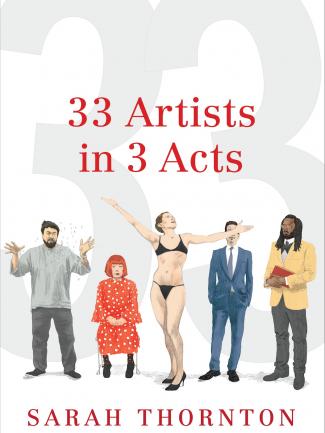As a working musician, it’s hard to understand a world where a cow can be sliced in half, submerged in a tank of formaldehyde, then sold to an art collector for millions of dollars.
Making stuff like that sounds so much easier than obtaining a music degree, undertaking the work of song-craftsmanship, writing hundreds of tunes in the hopes that one of them (just one) gets played at my local grocery store. Heck. Just bring me Old MacDonald’s entire farm and I’ll run a 10-for-1 special.
Why do we musicians work so hard to insert beauty into a culture in which Italian artist Piero Manzoni gets paid $126,000 for Merda d’artista, a small can filled with his excrement. Where is the art in this?
This vexation lead me to read 33 Artists in 3 Acts (2014), authored by Economist contributor Sarah Thornton. The book provides a window into the lives of 33 artists and the $60 billion dollar global art market to which they contribute. Thornton’s book left me with me with good news and bad  news. First the good news.
news. First the good news.
Thanks to an unregulated art market, I am capable of throwing together a conceptual piece of art in just a few hours that, if presented correctly, will become an easy way for a white-collar criminal to transform his latest $10 million embezzlement into squeaky clean money.
I could blow up a photo of Lee Harvey Oswald, glue it onto a 10 ft. piece of aluminum, cut out eye-holes, fill the mouth hole with a rag, sell it at a Sotheby’s auction (I am not making this up) and be paid $6.6 million for the work.
The buyer can purchase the work using a credit card associated with a numbered Swiss bank account and avoid paying any kind of taxes because 1) Many galleries don’t report individual transactions – only quarterly earnings and 2) The sculpture can be shipped to a high-security warehouse in Bermuda known as a “freeport” – a place where, legally, assets remain “in transit” and therefore don’t really exist.
That’s all good news to me as an artist because it lets me off the hook in terms of being good at what I do. There’s proof I can put my kids through college without producing a masterpiece. No soulless bureaucrat or corrupt politician can prove my work ISN’T worth $20 million. Whew! I can continue being mediocre…..which brings me to the bad news.
These works aren’t mediocre. They are masterpieces. When you stand before them and behold, they really are. You don’t even need an open mind; a great artist will break your mind open with a crowbar.
I once stood in Atlanta’s High Museum of Art gazing over Radcliffe Bailey’s Windward Coast – a 10 foot by 10 foot room filled with piano keys and a few plaster heads sprinkled on top. That’s it.
But describing it to you that way feels criminal. Because Windward Coast took my breath away. It gave my brain a glorious beach ball of death. The  smell of it took me back to a lumber yard I visited as a child. It made me feel guilty for being white. It mashed elements together that shouldn’t be mashed together. The relentless intent of the artist – compounded by human effort – was palpable in the room. It was so much bigger than money. I hope whatever negotiations occurred between dealer and buyer happened in a different room so the energy wasn’t soiled.
smell of it took me back to a lumber yard I visited as a child. It made me feel guilty for being white. It mashed elements together that shouldn’t be mashed together. The relentless intent of the artist – compounded by human effort – was palpable in the room. It was so much bigger than money. I hope whatever negotiations occurred between dealer and buyer happened in a different room so the energy wasn’t soiled.
And suddenly I’m in the same company as our money launderer and government official; I too can’t possibly put a price on this. And suddenly my inner-artist realizes I can’t be mediocre. My nose has to get back on that grindstone. Ugh.
But for all the cynicism and humility 33 Artists in 3 Acts generated in me, in it I also found a role-model. A role-model who does not cut cows in half. She just works really hard.
Like many middle-class Americans, when I think of art, I think of paintings. Good old-fashioned acrylic-on-canvas-paintings. Beatriz Milhaze, 56, is a Brazilian painter who produces roughly six paintings a year. Starting out, she co-opted studio space with some fellow art students who, in Milhaze’s words, “were there to listen to music and party…I was there to paint.” Today she is the highest paid female artist in Brazil. And yet Milhaze sees her job as no different than a banker (“I go to work every day. I pay attention to detail. I try not to make mistakes.”)
Milhazes’s brilliance can be felt just by looking at Google images. Here’s what a mere “banker” can do when she applies her nose to a grindstone. Hold your breath:
Sources:
33 Artists in Acts by Sarah Thornton
https://en.wikipedia.org/wiki/Damien_Hirst
http://www.oddee.com/item_98781.aspx
http://www.latimes.com/books/jacketcopy/la-ca-jc-sarah-thornton-20141123-story.html
http://artsbeat.blogs.nytimes.com/2015/05/11/two-art-works-top-100-million-each-at-christies-sale/?_r=0
https://en.wikipedia.org/wiki/Cady_Noland
https://www.high.org/Art/Exhibitions/Radcliffe-Bailey.aspx
https://en.wikipedia.org/wiki/Beatriz_Milhazes
http://www.hopesandfears.com/hopes/culture/art/214699-guide-to-laundering-money-art
http://www.barrons.com/articles/stashing-your-art-in-a-tax-haven-can-be-dicey-1445663281
https://en.wikipedia.org/wiki/The_Physical_Impossibility_of_Death_in_the_Mind_of_Someone_Living
https://sites.duke.edu/blackatlantic/sample-page/depictions-of-the-middle-passage-and-the-slave-trade-in-visual-art/levitate-windward-coast-and-vicissitudes-curatorial-statement/radcliffe-bailey-levitate-and-other-works/
___________________________________________________________________________________________
Mike Bielenberg is a professional musician and co-founder of http://www.musicrevolution.com, a production music marketplace with over 45,000 tracks online where media producers, video producers, filmmakers, game developers, businesses and other music buyers can license high-quality, affordable royalty-free music from an online community of musicians. mbielenberg@musicrevolution.com. ![]()